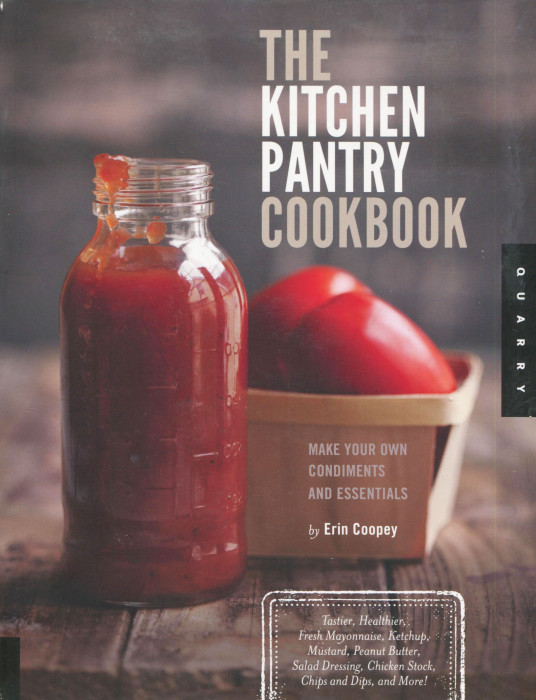“I don’t want you to think of this as an intervention,” my daughter Kelly began. She was walking from our panty towards Suzen and me. She had a jar in each hand.
“Have you read the dates here?” Kelly questioned.
That’s bad. I turned to Suzen. She turned to me with one of her “that’s supposed to be your job” look.
“Uh, Kelly,” I started, “I may have missed a thing or two.”
“This jar is almost from the last century,” Kelly noted. “And,” she continued, “have your read the ingredients? You have to stop buying this stuff.”
We built our pantry fifteen years ago. Twelve years ago, I added shelves. They are filled. Side to side. Front to back.
Suzen and I like stuff. Condiment stuff. Pickle stuff. Relish stuff. Vinaigrette stuff. We like them, we love them, we buy them, we put them up on the shelf, and we forget them.
“You need to start making this stuff for yourselves,” Kelly said.
We nodded in agreement. How could we disagree with her? Suzi taught her food. I taught her cocktails. Somehow in the decades, Kelly seemed to have advanced beyond us both.
“I can help you,” Kelly finished.
Two weeks later we got this book, signed by the author, Erin Coopey. The Kitchen Pantry Cookbook has chapters for those things Suzi and I love, that you love:
- Condiments
- Nut Butters and Spreads
- Salad Dressings
- Stocks
- Relished and Refrigerator Pickles
- Chips, Dips, and Dunks
So here you find recipes for “basic” but vital elements in our food lives. Things like:
Tartar Sauce
Dijon Mustard
Lemon Curd
Cashew Butter
Garlic Dill Vinegar
Garlic Vinegar
Chicken Stock
Beef Stock
Corn Relish
Sweet Pickle Relish
Scallion Dip
Spinach Dip
Ah, these recipes sound so familiar, so basic, so common. What makes them worth exploring in this book? Oh, lots of things. Lots.
I hold in my hand a bottle of ketchup, a good upscale ketchup that Suzi and I love. I won’t name it, but I want to give you the list of ingredients, which come in the order of most used to least:
- Water
- Tomato Paste
- Pure Cane Sugar
- Glucose
- Habanero Peppers [this a habanero ketchup just so you know]
- Salt
- Starch
- Acetic Acid
- Garlic
- Citric Acid
- Onion
- Ascorbic Acid
I have no idea what “starch” means for why it’s there. I guess some food science guru figured out that you need both citric and ascorbic acid. I have to repeat this: the ketchup tastes wonderful. But those ingredients give me pause.
Now let’s consider the recipe for ketchup in The Kitchen Pantry Cookbook:
- 2 ¼ pounds plum tomatoes
- 1 ½ cups distilled white vinegar
- 2 ½ teaspoons coarse sea salt or kosher salt
- 1 cup (200 g) sugar
- 1 tablespoon grated onion or 1 teaspoon onion powder
- ½ teaspoon mustard powder
- ¼ teaspoon ground cinnamon
- ¼ teaspoon ground cloves
- ¼ teaspoon ground allspice
- ¼ teaspoon ground black pepper
Well, the sugar is still there but life seem pretty different here. Real tomatoes and not tomato paste, for example. Spices, not starch.
In the headnotes for her ketchup recipe, author Erin Coopey says that “You’ll think you’re eating a national brand — minus the high-fructose corn syrup!” No, kidding. Suzi and I have transformed our ketchup lives. This recipe really is better and, more, it gives us leeway to experiment. Some more mustard, lots more clove, a little less vinegar, a different style of plum tomatoes. What we don’t do is start making our ketchup by getting water and tomato paste ready. We start from scratch, we take our time, and we relish the delights.
I hope this one example gives you the motivation to look at this clever book and enjoy it page after page. Suzi and I do.


Hi, I hope you are enjoying the book and have tried some of the other recipes since writing this. Have you had a chance to make the spicy version of the ketchup. Since you enjoy habanero ketchup, I think you'd enjoy it too. It doesn't contain chiles but the cinnamon provides a good kick. Thanks so much for the mention! My newest cookbook, Infusing Flavors, just came out. I'd be happy to send you a copy if you'd like. Best, Erin Coopey
I love your book. No, I’ve not made the ketchup. Not yet, But we might try this summer. I would appreciate seeing your new book, Erin. I’m sure it is great.
Shoot me an email with your address and I'll send one out to you. 🙂